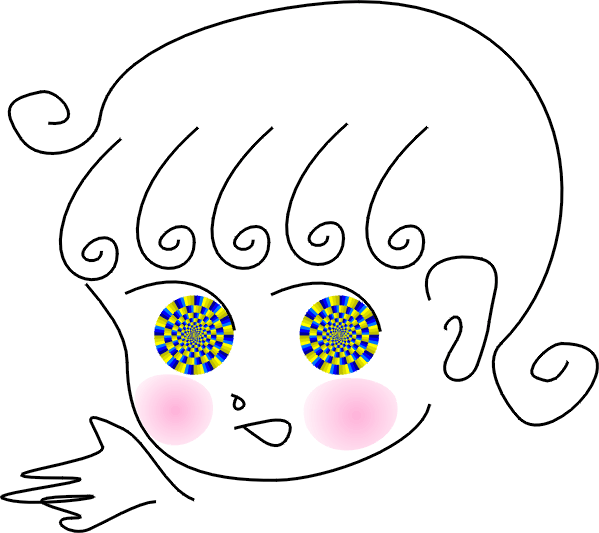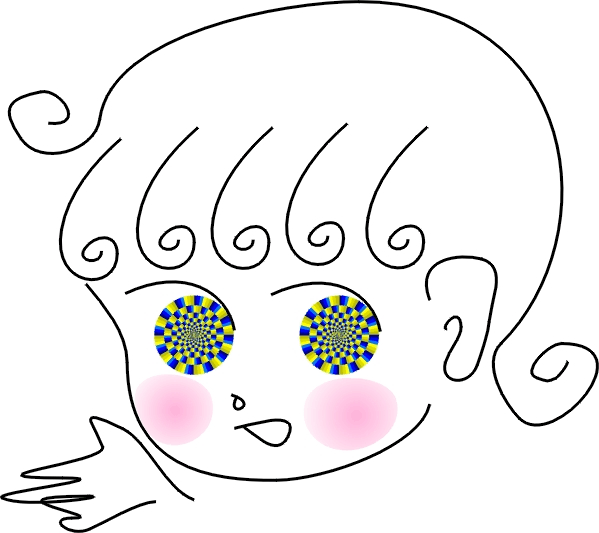 A girl of blue eyes
A girl of blue eyes 
 A girl of blue eyes
A girl of blue eyes 
since March 2, 2006
Warning: This page includes real animations. Please do not keep watching them for a long time. Although this page has carefully avoided the known harmful stimuli, unknown ones might happen to be included. Never copy them.

"A quick change"
Something changes when one image changes to the other one, but it takes time for observers to detect it. This phenomenon is called "change blindness".
Copyright Akiyoshi Kitaoka 2006 (March 3)
Rensink, R.A, O'Regan, J.K, & Clark, J.J. (1997). To see nor not to see:
The need for attention to perceive changes in scenes. Psychological Science, 8,
368-373.
Simons, D.J., & Levin, D.T. (1997). Change blindness. Trends
in Cognitive Psychology, 1, 261-267.

"Whiskers"
Whiskers appear to grow up quickly or return rapidly. This appearance depends on the line-motion illusion.
Copyright Akiyoshi Kitaoka 2006 (March 2)
Hikosaka O, Miyauchi S, Shimojo S, 1993a ``Focal vision attention produces
illusory temporal order and motion sensation'' Vision Research 33 1219-
1240
Hikosaka O, Miyauchi S, Shimojo S, 1993b ``Voluntary and stimulus-induced
attention detected as motion sensation'' Perception 22 517-526

"Swings"
She appears to swing her hand repeatedly. This appearance depends on apparent movement with speed lines.
Copyright Akiyoshi Kitaoka 2006 (March 2)
"Jittering eyes"
Both eyes are stationary but appear to jitter slightly after the motion of the other parts stop. My opinion is that this may be the visual jitter illusion.
Copyright Akiyoshi Kitaoka 2006 (March 2)
Murakami, I. & Cavanagh, P. (1998). A jitter after-effect reveals motion-based stabilization of vision. Nature, 395, 798-801. [abstract] [DEMO]
"A demonstration of representational momentum"
Both eyes move rightward from the left hand, disappears, and then appear again at the same place as the position where they disappeared. "Representational momentum" refers to an illusion that the eyes appear to appear again at the left side from the position where they disappeared. (though I do not see so...)
Copyright Akiyoshi Kitaoka 2006 (March 2)
Freyd, J. J., & Finke, R. A. (1984). Representational momentum. Journal of Experimental Psychology: Learning, Memory, and Cognition, 10, 126-132.
"Goggly eyes"
Both eyes rotate clockwise and pause a little, which gives a goggly sensation.
Copyright Akiyoshi Kitaoka 2006 (March 1)
"A girl of rotating blue eyes: a reversal"
Both eyes rotate clockwise for five seconds and pause for three seconds. In the pause, the eyes appear to rotate counterclockwise. This effect is the motion aftereffect.
Copyright Akiyoshi Kitaoka 2006 (March 1)
Larger image (Motion aftereffects in the girl of blue eyes)

"Wink"
The left eye appears to wink sometimes. This effect is the apparent movement.
Copyright Akiyoshi Kitaoka 2006 (February 27)

"A girl of anomalously rotating blue eyes"
Both eyes appear to rotate along the gravity axis. This effect is an example of shape constancy.
Copyright Akiyoshi Kitaoka 2006 (February 27)

"A girl of quickly rotating blue eyes"
Eyes appear to rotate quickly in any direction.
Copyright Akiyoshi Kitaoka 2006 (February 27)

"A girl of blue eyes"
Eyes appear to rotate clockwise... (though I am afraid that the image is too small for illusion)

Image that is large enough for illusion
Copyright Akiyoshi .Kitaoka 2006 (February 27)
Applied illusionology --- Miscellaneous 4